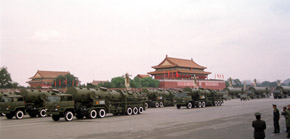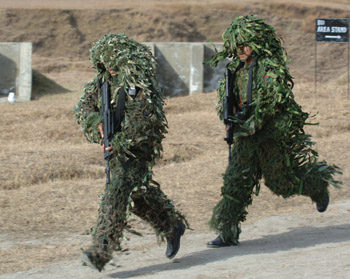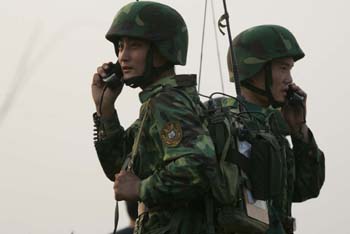Eighty years ago, the forerunner to
During China's War of Liberation (1945-1949), few people anticipated that the PLA, with their "xiaomi jia buqiang" – "millet and rifle" would finally defeat the far superior US-equipped Kuomintang troops within a few years. The sweeping victory led to the founding of the People's Republic of
When Mao Zedong, one of the founders of the PLA, reviewed the first military parade of the Chinese army in 1949, 95 percent of the weapons on display were captured in battles, and 17 fighter jets were all that the new-born PLA air force had to boast of.
In comparison, the 1999 military parade marking the 50th anniversary of the founding of the People's Republic of
|
The PLA air force has been equipped with F-10 that is |
The missile frigate of the PLA navy is lunching electronic countermeasure missiles in the exercise. |
Since the past few years, the PLA has been on a fast track to modernize its forces and combat capabilities as well as information related technical aspects.
The modernization of national defense capabilities with advanced science and technology has been high on the agenda of the Chinese leadership. While meeting military delegates last month, Chinese president Hu Jintao, who is also chairman of the CPC Central Military Commission, called for greater efforts to modernize the country's armed forces to ensure national security.
|
On November 12th,2006, the PLA was taking part in a electronic countermeasure exercise in complicated electromagnetic atmosphere |
|
Alongside the modernization drive the army's human resource has greatly improved.
The statistics from 2002 indicated that more than 26,000 doctorate and masters degree holders are working in the military, and over 95 percent of the officers have a bachelor's degree. A large number of the PLA officers are also being sent to study at military schools in developed countries every year. Now the army is working on a strategic project to train a large cadre of troops who will be competent in operational tasks involving information technology, and help the armed forces.
|
On December 14th, 2006, two armed PLA soldiers were in the China-Pakistan joint anti-terrorist military exercise |
In recent years as the PLA continues to get better equipped and more efficient, it is becoming smaller in size. Following a downsizing of one million soldiers in the 1980s, its overall size was further reduced by another half a million personnel between 1997 and 2000. And from 2003-2005, the army has been further reduced by 200,000 troops, bringing the total PLA strength these days to 2.3 million.
|
PLA communication corps were training on October 14th, 2006, and preparing to win a high-tech war in the future |
Accordingly,
The goal of this modernization drive has been clear from the beginning, and it is to be more efficient in the country's self defense. "The more modernized the army becomes, the more solid will be its combat capability. And such solid capability will further benefit the cause of peace and unification," said Professor Pan Rixuan of the
"
The former Defense Minister Chi Haotian summed up





